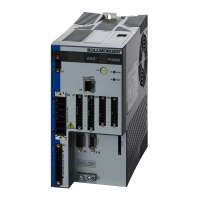Mode:
Select the mode (WS.MODE) according to your application needs [insert guidance on how to select]
Arm:
Click Arm to set WS to start at the next drive enable (WS.ARM). This area also shows the current status of the
wake and shake process. See WS.STATE for a detailed explanation of the possible states.
WS.ARM is not relevant to any feedback type.
Settings:
l Number of Wake and Shake Loops. By default, the WS feature uses the mean of all wake and shake
repetitions, called "loops", to establish commutation (WS.NUMLOOPS; see Using WS: Advanced for a
discussion of loops). If fewer than five loops are used, commutation may be incorrect, possibly causing
poor performance or stability.
l Time the current vector applied to motor.This box specifies specifies the duration of the current pulse
used for commutation. Increasing this value (WS.T) increases the movement of the system in direct pro-
portion to the move distance (WS.DISTMAX or WS.DISTMIN.
l Maximum allowed velocity. If a velocity higher than this value (WS.VTHRESH) is detected while WS
is running, then a fault will be generated.
l Maximum allowed current. This value (WS.IMAX) is directly proportional to the movement. A value that
is too low may fail to cause movement; a value that is too high value may cause an over speed fault.
Wake and Shake, More View
To configure additional WS settings, click More at the bottom of the default view to display the following
options:
Wake and Shake Movement
Use these boxes to set values for the maximum (WS.DISTMAXand minimumWS.DISTMINmovement required
for finding commutation.
Delay Times
Delay time is the time that elapses when switching different current vectors. Use these boxes to set specific
time delays for current steps WS.TDELAY1, coarse to fine angle (WS.TDELAY2) and time between loops in
mode 0 (WS.TDELAY3).
Special Cases for WS
Operation with Motor Brake
An amplifier with a motor brake operates the WS procedure similar to an amplifier without a brake. All pre-
cautions and behavioral descriptions above also apply in this case. It is important to note that the brake is
AKD User Guide | 8 Configuring Motor Settings
Kollmorgen | December 2010 65

